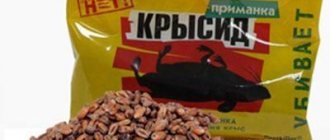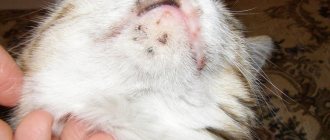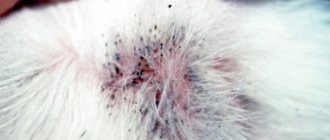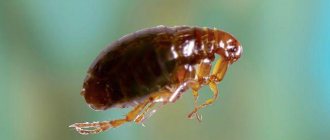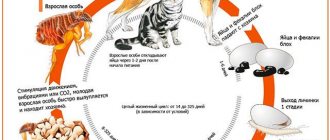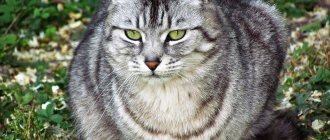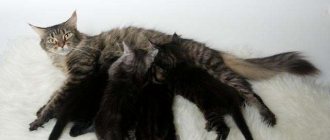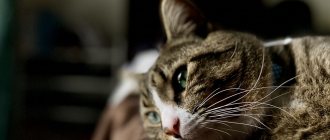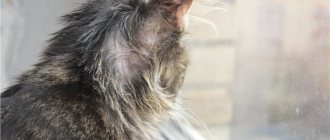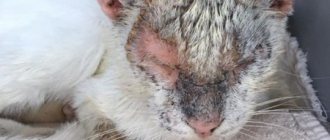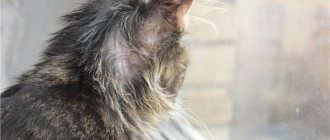Water is an essential element without which no living creature can exist. Cats are no exception; they must receive a sufficient amount of moisture for normal well-being, stable functioning of internal organs, and prevention of many diseases. At the same time, many owners are faced with the fact that the cat drinks little or refuses water altogether. What to do in such situations, how to force a cat to drink - this will be discussed further.
For picky pets, you can purchase a reliable automatic waterer, which will attract the animal’s attention every time with the murmur of water:
note
Quick view
Automatic drinking bowl for cats and dogs Feed-Ex CatH2O (1 piece)
1 PC
2 755 ₽
2 470 ₽
Show all offers
Quick view
Automatic drinking fountain for cats and dogs Feed-Ex Spring (1.8 l)
1.8 l
3 248 ₽
2 912 ₽
Show all offers
Quick view
Automatic waterer for cats Ferplast Vega Fontanella (2 l)
2 l
4 443 ₽
4 067 ₽
Show all offers
Quick view
Automatic drinking fountain for cats and dogs Feed-Ex Lotus, blue (1.5 l)
1.5 l
2 490 ₽
2 232 ₽
Show all offers
Quick view
Automatic drinking fountain for cats and dogs Feed-Ex Lotus, pink (1.5 l)
1.5 l
2 490 ₽
2 232 ₽
Show all offers
Quick view
Automatic drinking bowl for cats and dogs Feed-Ex Drinkwell Mini (1.2 l)
1.2 l
4 565 ₽
4 094 ₽
Show all offers
How dangerous is it for a cat to refuse water?
Felines by nature are light drinkers. Scientists explain this by saying that purrs descended from ancestors who lived in the desert, for whom living in arid areas and staying for long periods without fluid was the norm. In addition, pets receive a certain amount of moisture from food, provided that the owners have provided proper nutrition for the animal.
However, there is a fluid intake rate that it is advisable to adhere to:
- for adults - about 33 ml per 1 kg;
- for kittens up to one year – 70-80 ml per 1 kg.
Long-term refusal of fluids is fraught with dehydration and the development of urolithiasis, which causes a lot of problems for your pet. To prevent such a scenario from happening, you should think in advance about how to get your cat to drink. All methods will be good here, even the most creative and, at first glance, naive ones. Let's talk about them in more detail.
How to tell if your cat is not drinking enough water
An acute lack of fluid in the body at the cellular level leads to the fact that the cellular structures shrink, the blood and lymph circulating throughout the body become much thicker. Oxygen does not penetrate the cells in the required quantity, oxygen starvation occurs. Against the background of dehydration and serious disorders, pathological changes occur in the intestinal tract, ureter, and respiratory tract. The pet becomes lethargic, the coat becomes dull, and the animal’s state is apathetic.
It is necessary to understand that young animals in good health can be without drinking water for a long time - for 3-4 days. The older the animal is or has a history of a number of chronic diseases, the higher the risk of pathological changes when dehydration occurs. The body's reserves are depleted, which provokes severe problems, which ultimately leads to death.
Unlike dogs, cats are not particularly fond of drinking water, especially in large quantities. However, their need for clean drinking water is significant. Cats need much less fluid per day than dogs or other animals, but without water the body cannot function normally.
As a result of the fact that water is an important component of both cellular structures and intercellular space, the biological properties and structures of elements are determined, influencing the process of thermoregulation of the body and the transfer of useful components.
Regular loss of fluid occurs in the body along with salivary fluid, urine and feces. In the absence of replenishment, serious complications arise that provoke problems in the functioning of the entire body.
If a cat refuses to drink on its own, the risk of dehydration increases. Against the background of dehydration of the whole body, internal organs begin to suffer, and first of all, the central brain. All metabolic processes in cells are disrupted.
Scientists have proven that with a percentage loss of body fluid of up to 10%, there is a high risk of developing irreversible processes in the tissue structures of the body. If the percentage of fluid loss exceeds 15-20%, the animal may die. Dangerous conditions that lead to a sharp development of dehydration are stool disorders (profuse diarrhea), persistent vomiting, extensive hemorrhages (especially internal bleeding) against the background of injuries to internal organs, edematous conditions. In addition to fluid, the body loses a large amount of microelements, vitamins and other nutrients.
Such conditions and changes in the body are difficult to normalize. As soon as the owner notices a problem in the pet’s health, it is recommended to immediately contact a veterinary clinic for help. Only in a hospital hospital setting is it possible to carry out infusions of saline solutions, glucose or other substances that maintain the body’s water balance at the required level, avoiding the development of complications.
Water bowls should be everywhere
Cats are quite capricious animals, many of them are convinced that the whole world revolves around them. They decide for themselves where to sleep, where to play and where to drink water. Therefore, when answering the question of how to get a cat to drink water, many make a knight’s move and place containers of water in different places.
Soon the animal will independently determine in what place it will be convenient for him to drink water. Perhaps in this simple way you will be able to solve the age-old problem of how to teach a cat to drink water.
How much water should a cat normally drink per day?
Cats' fluid intake varies from person to person. It depends on several factors:
- Animal weight. For every kilogram of body weight of a four-legged pet, ideally there should be from 20 to 40 ml of water per day, according to other sources - about 50 ml.
- Age. Kittens require less fluid than their mature counterparts. Most older cats are thirsty.
- Nutrition. A pet that eats high-quality ready-made food that does not contain salt and has a balanced composition needs less water than its counterpart that eats a low-quality product. Broths and gravies included in a cat's diet, which consists of natural food, provide their body with moisture, as a result of which the pet's need for clean water is reduced.
- Level of physical activity. Energetic cats require more fluids than four-legged couch potatoes.
- Time of year and air temperature in the room where the pet is constantly located. In the heat, the need to drink increases.
An animal's daily water consumption should be twice the weight of food it eats. Knowing your pet's weight, you can determine how much fluid he needs per day. To do this, you need to multiply its mass by 0.03. The resulting value will be the norm of water required by the cat’s body.
Introduce wet food into your pet's diet
The animal must receive a sufficient amount of moisture from food, for this purpose it is necessary to ensure that the pet eats properly. In order not to think about how to get your cat to drink water, you can transfer the purr to high-quality canned food from the holistic or super-premium segment.
At the same time, it is important to preserve the animal’s established preferences; if the cat is accustomed to eating fish-flavored dry food, the choice of canned food should be identical.
How much should a cat drink?
Veterinarians have developed a formula for calculating the amount of water per day for a cat. For every kilogram of weight, 80 ml of water is required.
An adult cat should drink about a glass of liquid per day. There is no need to worry if your pet drinks a little less than it should. Maybe he just doesn't want to. People also don’t always drink enough water.
The amount of fluid per day includes not only water. Some cats prefer to drink broth or dairy products. Fluid intake will be reduced if your pet eats wet food and soups.
Drinking fountains
Automatic waterers have come into use among pet owners relatively recently, but have already gained an impeccable reputation and rave reviews.
Purrs love the sound of rushing water, perhaps it reminds them of life in the wild, or just gives them another reason to frolic with the water stream. Many models of automatic drinkers are equipped with carbon filters that remove unpleasant odors and keep the water fresh for a long time.
Manufacturers recommend changing them every 6-8 weeks depending on the level of fluid consumption and the quality of the water being poured.
Choose the right bowl
Cats are not only gourmets, but also true aesthetes; they will not eat or drink from just anything. It might be worth trying to buy new water containers or change them periodically in the hope of finding the one that purrs will approve.
It could be:
- automatic drinker;
- ceramic bowl;
- metal utensils;
- bowls on a stand.
Despite its absurdity, this method is often the solution to getting a cat to drink more.
What to feed a cat with poor appetite?
If you are sure that your cat is healthy, but refuses to eat under the influence of external factors, you can try to “tease” its appetite. Veterinary clinics often use special liquid foods that have a very distinct aroma that is attractive to cats. Just put a little food on your finger and let your cat smell it. If she doesn't lick the food, touch her nose or upper lip. Instinctively, the pet will lick itself and taste the food. If the reason for food failure is due to external factors, this should be enough.
If the cat is very nervous and refuses food due to a “lump in the throat,” an attractive taste is not enough. It is better to use natural products after special preparation:
- Warm your food – Warm food has an attractive aroma.
- Crush the treat – Quite often cats refuse to chew, but will willingly lick the food.
- Don't push - even if the cat licked the treat only once, this is already progress. Do not force your cat to eat more and more, it is better to offer her a treat a little later.
- Don't wake her up - when a cat sleeps, it restores its vitality, and this is (almost always) more important than food.
There is an unspoken list of foods that provoke appetite in cats:
- Tuna canned in oil or its own juice.
- Shrimp and other crustaceans, only boiled.
- Infant milk formulas and meat purees without vegetables and berries.
- Boiled squid without salt.
- Smoked meats (under normal conditions this should not be given to a cat).
- Warm meat broth, you can add a little raw yolk.
- Boiled chicken or beef liver – you need to chop it and dilute it with broth.
Only as prescribed by a veterinarian, a cat can be fed liquid food from a syringe. This method is applicable in almost all cases if the cat can swallow. If your pet does not have problems with teeth and swallowing, you can try to induce an appetite by example.
Sit opposite the cat and start eating, preferably something aromatic. Bite and chew slowly; if your cat follows your movements, this is a good sign. They took a bite, started chewing, put the plate aside, and offered the cat a treat. This algorithm allows you to reach basic instincts, show your trust, and guarantee the safety of your pet.
Encourage your furry's quirks
If you are faced with the task of getting a cat to drink water when dehydrated, or if your pet is suffering from urolithiasis, you can use the most unconventional methods.
For example:
- allow your cat to drink from the tap, but only if it contains clean, filtered water;
- if the cat likes to drink from a cup or glass, replace the usual bowl with a new container, etc.
It is important not to resort to extremes in trying to get your cat to drink more water - do not allow him to quench his thirst in the toilet, deep buckets or running bath. Doing so may cause poisoning or may result in falling into a container of water.
How can this problem be solved?
First we need to discuss water quality.
Cats will always prefer fresh, clean water to stagnant or cloudy water. Therefore, the water should be changed daily or even several times a day - it will only be better. If a dog lives in the house with a cat, then it will probably drink from the same bowl, which can also affect the cat’s attitude towards such water. In this case, you should block the dog's access to the cat's drinking bowl. For example, a bowl can be placed on a windowsill.
One of the unsuccessful options for a water container is a double bowl into which both food and water are poured. In bowls with a similar device, food particles often fall into the water, contaminating it. The same thing happens when the water bowl is too close to the food bowl. Also, you should not use the same bowl for eating and drinking; in other words, the drinking bowl must be a separate container.
Care should be taken to ensure that the water does not contain any impurities and does not have any repulsive odors. Perhaps you should refrain from using various detergents and cleaning products, since they leave odors that the cat will not necessarily like. Although it can be argued that she will not like them for sure.
